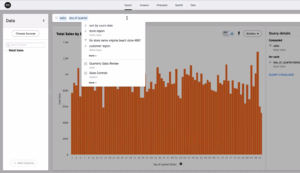
Seizing Business Opportunities at the Speed of Thought

When Sudheesh Nair suddenly left the president’s post at Nutanix to occupy the CEO seat at ThoughtSpot earlier this year, it raised a few eyebrows. After all, Nutanix was one of the hottest firms in the market for hyper-converged systems and software-defined storage. But as Nair explains, the potential to ride a disruptive wave of analytic software innovation was just too great to pass up.
Under six years of Nair’s leadership at Nutanix, the company grew from practically zero in revenue to almost $1.2 billion in fiscal 2018. It went public in 2016 (NASDAQ: NTNX) and today has a market capitalization of nearly $7 billion. As adoption of cloud computing forces tech executives to rethink computing architecture, it only adds to the long-term value of hyper-converged stacks like the one that Nutanix built.
Despite the success at Nutanix, Nair felt a nagging urge that more could be done, that he should be doing more. “Every time you meet with business decision makers [at Nutanix], the primary reason they want to talk to you is they want to squeeze more dollars out of you to get a better price,” Nair tells Datanami. “So it became a part of saving money for the customer, which is not a bad thing. But in the world you live in [big data analytics], it’s about making more money for customers.”
As CEO of ThoughtSpot, Nair thinks he has found such a job.
Who Is ThoughtSpot?
ThoughtSpot was founded in 2012 by a group of former employees from Google, Oracle, Microsoft, Yahoo, and other Silicon Valley firms. Among the founders is Ajeet Singh, who also co-founded Nutanix and provides Nair with a link to his former company. Based in Palo Alto, California, ThoughtSpot has raised more than $300 million, and is said to be on track towards an IPO.
The company develops its own distributed data analytics stack that Global 5000 firms can use to enable non-technical workers extract insights from large amounts of data, without involving external data scientists or data analysts.
At the bottom of the Spot IQ stack is a distributed, in-memory, relational database, called Falcon, that speaks SQL, is designed to crunch hundreds of terabytes and billions of rows, and deliver results in near real time. Customers can have dozens or hundreds of nodes in their Falcon clusters.
The proprietary Falcon is faster than SAP HANA, Nair claims, and extensive infrastructure work has gone into it to ensure that performance doesn’t degrade as the scale increases. Most customers feed Falcon from existing data warehouses, either on-premise or in the cloud, such as Teradata and Amazon Redshift MPP databases, Hadoop and S3 data lakes, and Salesforce and Oracle enterprise applications.
“We’re not replacing your existing data warehouse,” Nair says. “We actually make this the front-end to the vast amount of that is sitting there. Think of it like an insight gateway, so to speak.”
Atop this distributed database – which can exist on-prem or in the Amazon or Azure clouds — ThoughtSpot provides several interfaces, including a search engine that allows users to ask questions of the data using natural language, and a series of pre-canned visualizations that allow users to peruse data at fine-grained levels from a number of angles.
ThoughtSpot surrounds the entire offering with machine learning algorithms designed to learn how people use the product over time, with the goal of suggesting possible queries and letting the product itself surface trends in the data that the human users might have missed.
Driving Data Innovation
During a demo with Datanami, Nair drove the product and showed how the product recommends a number of visualizations – sales by product, sales by region, sales by period — based on the queries he enters into a search bar. The user can select any of them and pull them up on the screen.
“This system is interacting with me directly and I can build my own queries without knowing anything about it,” Nair says. “It’s like Google search, in a sense, but the difference here is it’s all coming from structured data. As you can see, as I’m typing … it is going to pick the right visualization metric also for it.”
ThoughtSpot competes against all the usual suspects in the business intelligence and analytics market, including established brands like Tableau, Qlik, Microsoft, and MicroStrategy, as well as emerging names like Looker, Zoomdata, GoodData, and others. It has done well in analyst reviews,
“Tableau is a fantastic technology, but it’s from the late 90s,” Nair says. “We think the real problem of the future is going to be volume and latency — that is, the amount of data that’s created and how fast you want to derive insight form it.”
For example, if demand for a product is going to jump because an influencer on Twitter posted a flattering review, then the quicker a merchandising manager can tweak her supply chain, the better the odds of being able to capitalize on change in demand.
“It’s one thing to say I have a system that answers my questions,” Nair says, “but it’s a really different thing when the system will tell you, these are a few things you should be thinking about.”
AI-Human Partnership
ThoughtSpot’s use of machine learning technology gives the company an edge in identifying insights. It’s not that these insights can’t be found and delivered the traditional way – by having groups of data analysts perusing through the data – it’s just potentially quicker to have machine learning do some of the work.
“The haystack has become so big that it’s somewhat impossible for us to find the needle in the time that we have,” Nair says. “The system needs to say ‘Look, there’s a higher probability that we’re going to find a needle in top northwest corner of the haystack.'”
This partnership between AI and humans is potentially very fruitful, and an area that ThoughtSpot hopes to drive innovation in the future. There are all sorts of capabilities the company could deliver in that area, such as delivering voice-driven queries, or incorporating weather data into predictions.
“Right now we haven’t enabled that sort of thing,” Nair says. “But we will bring those sorts of capabilities into the system so an enterprise customer can not only make a business decision based on domain specific data inside of their data warehouse and sources, but also go out and connect to weather data and social media data to make intelligent decisions.”
By doing the tough work of developing its own distributed infrastructure, ThoughtSpot has prepared itself to ride an innovative wave forward into whatever the future can deliver.
“We are just getting started,” Nair says. “The last five years have been about putting the infrastructure, this in-memory database and all the interfaces tougher. But in the coming years our goal is to deliver more and more applications on the infrastrucure we’ve built.”
Related Items:
ThoughtSpot Eyes Exit with Latest Funding Round
ThoughtSpot, Search Engine Startup, Raises $50M
Rethinking Enterprise Search for the Big Data Age
Editor’s note: This article has been corrected. Sudheesh Nair was the president at Nutanix, not the CEO. Datanami regrets the error.




























